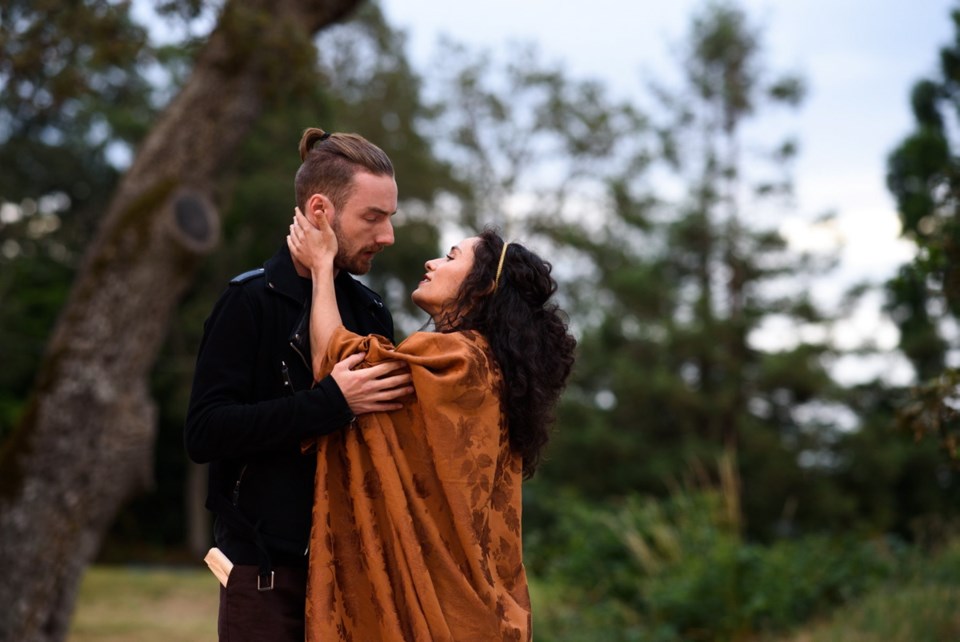The overwhelming temptation is, of course, to use Shakespeare’s Julius Caesar to poke fun at the blustering American leader with the cotton-candy bouffant.
Soon after Mr. Trump was elected, the U.S. blossomed with Donald-skewering theatrical fare. This bountiful crop included a New York version of Julius Caesar in 2017 featuring a petulant blonde Caesar with his pettish Slavic spouse.
English professor Erin E. Kelly makes note of this example in her program note for the Greater Victoria Shakespeare Festival’s entertaining production of Julius Caesar. Certainly a Donald-bashing approach does make sense — after all, Shakespeare presents Caesar as an ambitiously power-hungry type who would be king.
Yet director Tamara McCarthy resists the temptation to skewer Trump in her well-rehearsed production, now playing the grounds of Camosun College’s Lansdowne Campus. Caesar, played rather blandly by James McAndrew, is a bald-pated leader in a military jacket with stripes. The show is set in an unspecified era with few clues as to time period. There’s little in the way of set other than a few stone blocks and chunks of column. Meanwhile, the actors sport everything from L.L. Bean plaid shirts to Portia’s red Grecian-style gown.
It could be McCarthy decided blatant references to America’s wanna-be Caesar would unbalance this play — and indeed, it’s a relief to spend a Donald-free evening. This 21Ú2-hour (with intermission) show is directed with clarity and an emphasis on the basics. The performers project well (a must for outdoor theatre); the script is judiciously trimmed and streamlined for modern audiences.
The mostly young cast exudes energy, routinely dashing to the stage from adjacent fields to deliver news of battles. And there’s the summery pleasure of watching theatre on cushioned lawn chairs under a silvery half-moon amid Garry oaks and rolling hills.
We all know the tale. Caesar aspires to be emperor. Jealous Cassius plots Caesar’s overthrow with Brutus, an honourable man torn between his love of Caesar and his belief no one person should rule the country with an iron glove. Ultimately, JC is stabbed to death, with Caesar infamously exclaiming: “Et tu, Brute?”
In this show, which makes use of cross-gender casting, Stephanie Bright plays Cassius, Brutus’s ally and friend. The leather-vested actor presents him as a passionate and even hot-headed character who on Thursday night occasionally howled heavenwards with a grainy-throated voice (perhaps her timbre was affected by previous performances). There’s something intriguing about this interpretation; at the same time, the performance was somewhat one-note — we didn’t get a full sense of Cassius’s craftiness and complexity.
Angela Kostiniuk, playing Antony, also projected well in a stout-hearted manner. Yet again, we didn’t get a sense of the character’s complexity, particularly with her forthright delivery during Antony’s artful funeral oration (“I come to bury Caesar, not to praise him, etc.”).
The best role is Brutus, the personification of the moral ambiguity that is Julius Caesar’s overriding theme. Brutus is a good and brave man, yet he is fatally flawed: arrogant at times, easily persuadable, politically naïve. Jack Hayes as Brutus offered one of the evening’s strongest and most consistent performances, using a penetrating and incisive delivery to tap into this character’s wellspring of sincerity and self-doubt.
Some actors did well in supporting parts. A good example is Taylor Lewis, who sparkled in a clutch of small roles: Metellus, Cinna, Titinius and a carpenter.
Not all of the direction works. McCarthy presents the moment of Caesar’s assassination abstractly, with red ribbons representing blood being pulled from the sides of his costume.
This seems overly stylized and self-conscious. Much better was Brutus’s subsequent appearance with blood-stained hands, graphically suggesting the horror of the murder without descending into a gore-fest.
McCarthy’s stylized approach did succeed later on during a dance-like battle scene. Other touches worked well, too, such as the percussion combo on a hillock (drum, cymbal, rain-stick) which accompanied portentous descriptions of meteor-crossed skies.
Julius Caesar runs in repertory with Two Gentlemen of Verona at Camosun College to July 27. This will be followed by performances of Two Gentlemen of Verona at Esquimalt’s Saxe Point Aug. 1 to 3.



